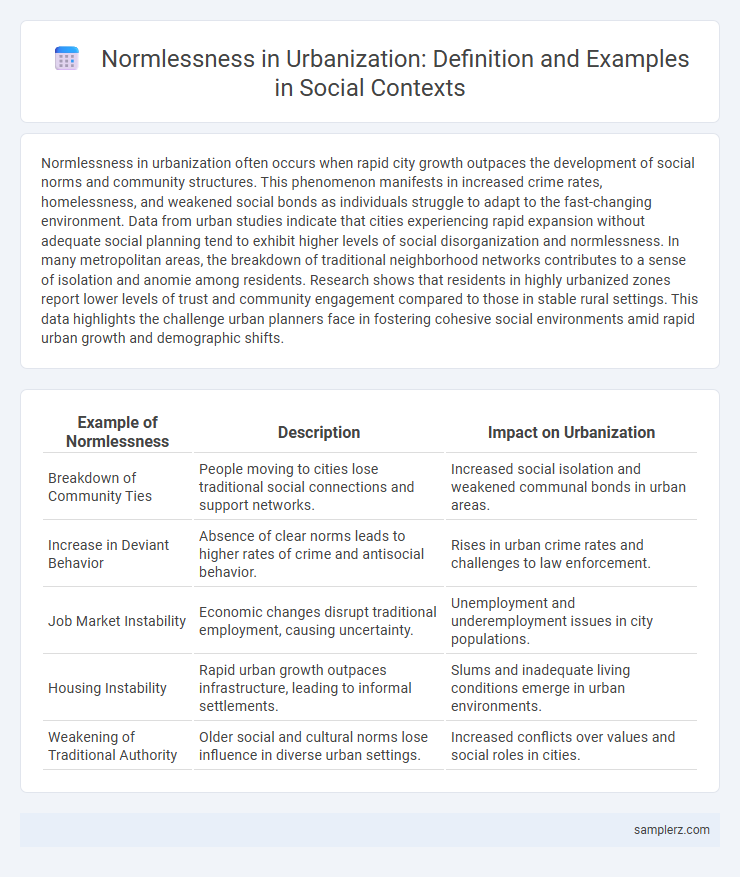Normlessness in urbanization often occurs when rapid city growth outpaces the development of social norms and community structures. This phenomenon manifests in increased crime rates, homelessness, and weakened social bonds as individuals struggle to adapt to the fast-changing environment. Data from urban studies indicate that cities experiencing rapid expansion without adequate social planning tend to exhibit higher levels of social disorganization and normlessness. In many metropolitan areas, the breakdown of traditional neighborhood networks contributes to a sense of isolation and anomie among residents. Research shows that residents in highly urbanized zones report lower levels of trust and community engagement compared to those in stable rural settings. This data highlights the challenge urban planners face in fostering cohesive social environments amid rapid urban growth and demographic shifts.
Table of Comparison
| Example of Normlessness | Description | Impact on Urbanization |
|---|---|---|
| Breakdown of Community Ties | People moving to cities lose traditional social connections and support networks. | Increased social isolation and weakened communal bonds in urban areas. |
| Increase in Deviant Behavior | Absence of clear norms leads to higher rates of crime and antisocial behavior. | Rises in urban crime rates and challenges to law enforcement. |
| Job Market Instability | Economic changes disrupt traditional employment, causing uncertainty. | Unemployment and underemployment issues in city populations. |
| Housing Instability | Rapid urban growth outpaces infrastructure, leading to informal settlements. | Slums and inadequate living conditions emerge in urban environments. |
| Weakening of Traditional Authority | Older social and cultural norms lose influence in diverse urban settings. | Increased conflicts over values and social roles in cities. |
Erosion of Traditional Values in Urban Centers
Erosion of traditional values in urban centers manifests through the decline of community rituals, weakened family bonds, and reduced social cohesion resulting from rapid urbanization. The anonymity of city life often leads to a breakdown in shared cultural norms and increased individualism, fostering normlessness. Studies show that urban residents experience higher rates of social alienation and moral ambiguity compared to rural populations.
Rise of Individualism Amidst Urban Crowds
The rise of individualism amidst urban crowds exemplifies normlessness as traditional social bonds weaken in densely populated cities. Urbanization fosters anonymity, leading people to prioritize personal goals over communal values, resulting in fragmented social cohesion. This shift increases feelings of isolation despite physical proximity, challenging established norms of collective behavior.
Breakdown of Community Bonds in City Life
Urbanization often leads to the breakdown of community bonds as rapid population growth results in overcrowded living conditions and social fragmentation. High mobility and anonymity in cities diminish interpersonal trust and weaken neighborhood networks, reducing social cohesion. The decline of shared norms and mutual support systems exacerbates feelings of isolation and normlessness among urban residents.
Anonymity and Alienation in Metropolitan Spaces
Anonymity in metropolitan spaces intensifies normlessness by eroding traditional social bonds and fostering alienation among urban residents. The lack of familiar social networks in densely populated cities disrupts communal norms, leading to increased feelings of isolation and social disintegration. This alienation undermines collective values, contributing to normlessness as individuals navigate impersonal urban environments.
Increase in Deviant Behavior within Urban Environments
Rapid urbanization often leads to normlessness, evident in the marked increase in deviant behavior such as vandalism, drug abuse, and petty crime within densely populated city areas. The breakdown of traditional community controls and social bonds in urban environments contributes to higher rates of antisocial activities and social disorganization. Studies in metropolitan centers reveal that the anonymity and social isolation of urban life can erode collective norms, facilitating the rise of deviance.
Challenges to Social Order in Rapidly Urbanizing Areas
Rapid urbanization often leads to normlessness, characterized by weakened social norms and increased anonymity, resulting in challenges to social order such as higher crime rates, social unrest, and weakened community ties. The influx of diverse populations in cities like Mumbai and Lagos intensifies competition for limited resources, exacerbating inequality and social fragmentation. Inadequate infrastructure and governance further hinder effective social regulation, contributing to disorder and instability in rapidly urbanizing areas.
Informal Economies as a Symptom of Urban Normlessness
Informal economies frequently emerge in rapidly urbanizing areas, reflecting a breakdown of formal regulatory frameworks and social norms. These unregulated markets often provide essential livelihoods for marginalized populations but simultaneously contribute to instability and social fragmentation. The prevalence of informal economies signals a normless urban condition where official governance fails to integrate all residents into structured economic activities.
Homelessness and Social Exclusion in Cities
Homelessness in urban areas exemplifies normlessness as individuals face social exclusion and lack access to stable housing, employment, and community support networks. The disintegration of traditional social bonds and the inadequacy of social safety nets contribute to increased marginalization and isolation of homeless populations. This normlessness exacerbates disparities in accessing healthcare, education, and social services, perpetuating a cycle of poverty and exclusion in rapidly urbanizing cities.
Escalating Crime Rates Linked to Urban Anomie
Escalating crime rates in rapidly urbanizing areas often reflect a state of urban anomie, where weakened social norms result from the breakdown of community bonds and ineffective social controls. High population density combined with economic disparities in cities exacerbates feelings of alienation, fostering environments conducive to criminal activities such as theft, burglary, and gang violence. Studies consistently show that neighborhoods experiencing rapid urban growth without adequate social infrastructure face significant challenges in maintaining public order and safety.
Impact of Urbanization on Social Control Mechanisms
Rapid urbanization disrupts traditional social control mechanisms by weakening community bonds and reducing informal social surveillance. Increasing population density and diversity in urban areas often lead to anonymity, making it harder to enforce shared norms and values. This normlessness can result in higher rates of deviance and social disorder due to diminished social cohesion and weakened institutional authority.

example of normlessness in urbanization Infographic
 samplerz.com
samplerz.com